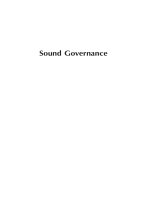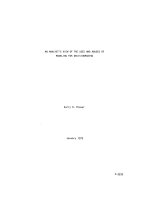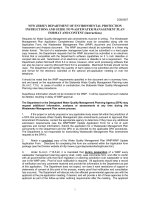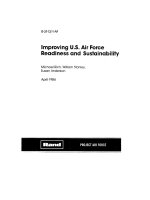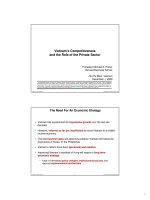VIETNAM s COASTAL MANAGEMENT GOVERNANCE, EFFECTIVENESS AND SUSTAINABILITY
Bạn đang xem bản rút gọn của tài liệu. Xem và tải ngay bản đầy đủ của tài liệu tại đây (2.62 MB, 197 trang )
VIETNAM’S COASTAL MANAGEMENT:
GOVERNANCE, EFFECTIVENESS AND SUSTAINABILITY
TRAN THI MINH HANG
NATIONAL UNIVERSITY OF SINGAPORE
2015
VIETNAM’S COASTAL MANAGEMENT:
GOVERNANCE, EFFECTIVENESS AND SUSTAINABILITY
TRAN THI MINH HANG
(B.Sc. (Hons.), M.Sc., National University of Singapore)
A THESIS SUBMITTED
FOR THE DEGREE OF DOCTOR OF PHILOSOPHY
DEPARTMENT OF BIOLOGICAL SCIENCES
NATIONAL UNIVERSITY OF SINGAPORE
2015
“Our choices at all levels - individual, community, corporate and government
- affect nature. And they affect us.”
David Suzuki, Suzuki Foundation
Declaration
I hereby declare that this thesis is my original work and it has been written by
me in its entirety. I have duly acknowledged all the sources of information
which have been used in the thesis.
This thesis has also not been submitted for any degree in any university
previously.
Tran Thi Minh Hang
18 May 2015
i
Acknowledgements
Foremost, I would like to express my deepest gratitude to Professor Chou
Loke Ming for his consistent support, invaluable guidance, and persistent
encouragement throughout my Ph.D endeavour. He has offered a wonderful
supervision and kind patience to help me see this project through to its
completion. Without his constant trust, I would have not come to this stage of
submitting the thesis. To me, he is the greatest supervisor one can ever have in
the entire life.
I am also greatly indebted to Professor Nguyen Chu Hoi from Hanoi
University of Natural Sciences for all the support he has provided. I learnt a
lot from him about Vietnam coastal management.
I am deeply grateful to all the staff in the Centre for Marinelife Conservation
and Community Development (MCD) for their support in my field study in
Vietnam, with special thanks to Ms. Nguyen Thi Thu Hue, Director of MCD
for her kind help. My research was also greatly assisted by IUCN Vietnam. In
particular, I wish to thank Ms. Bui Thi Thu Hien and Ms. Nguyen Thi Bich
Hien, who always supported and encouraged me during my research. Their
passion and valuable knowledge in marine conservation as well as kind
friendship have inspired me and helped me to believe in what I have chosen to
study. My sincere thanks also go to other governmental and research entities
in Vietnam for their support and sharing data, especially Ms. Tu Thi Lan
Huong from VASI for her valuable help.
Special thanks go to all members of Reef Ecology Lab for being great friend
and colleagues: Lionel, Tai Chong, Kok Ben, Yujie, Yan Xiang, Jessica, Rosa,
Valerie, Mei Lin, Siti, Lynette and Dexiang. I treasure so much all your help
and all the time we spent together, from lunch at Art Laksa to coffee-break at
YIH Yakun. You all make my time in NUS such an unforgettable journey.
I also treasure the friendship with other fellow students in the Biological
Sciences Department especially sister Thuy, Minh, Le, Son, Long, Maxine,
ii
Rob, Paul, Marcus and J.C. Their company has made my Ph.D life more
interesting and memorable. I would like to thank Dr. Ng Ngan Kee and Prof
Alex Ip for inspiring me so much on biodiversity and being a good teacher. I
am thankful to Ms. Reena and Ms. Priscilla for helping me with all
administrative matters throughout my long Ph.D journey.
I would also like to thank all my housemates in Lakeside House Phuong,
Khiem, Long, Hai Anh, my friends in Singapore Thu, Viet Anh, Van, Linh,
Lan Anh, Giang, Sie Huey, my friends in Vietnam Thuy, Hang, Hanh, Uyen.
Thank you for always being besides me through all bright and dark days.
Last but not the least, I am deeply grateful to have a loving family for always
standing by me and believing that I can “make it”. To my Mum & Dad, my
husband and my son, thank you so much for unconditional trust in me at all
times.
Thank you very much!
iii
Summary
This research is the first attempt to provide an overview of the current
progress of coastal management in Vietnam using a combined quantitative and
qualitative evaluation methodology. An initial review of the current status
indicates that, with the assistance from international organizations, Vietnam
has expended efforts in solving coastal issues including the ecosystem
degradation, pollutions and resources use conflicts through the
implementations of Integrated Coastal Management (ICM) and establishments
of Marine Protected Areas (MPAs). These initiatives are found to adopt very
different approaches in terms of the types of the originators, the sources of
funds, the supporting governance framework and the management approach.
The results of these efforts are also very different.
In an attempt to investigate and quantify the different results, the research
adopts a theory-based evaluation approach to examine the progress of ICM
and the effectiveness of MPAs in Vietnam. A cross evaluation was conducted
on seven representative ICM initiatives using an indicator-based frameworks
with 36 indicators for an ICM cycle. Similarly, a cross analysis and evaluation
of 8 representative MPAs was performed using a score-card survey where
MPAs were scored by 44 indicators in a framework recommended by the
IUCN-WCPA. The research was carried out at the national and local levels of
coastal governance and employed various data collection methodologies
including in-depth interviews, field observations, electronic survey and
secondary data mining.
To further confirm the evaluation results, a study of project stakeholders’
perceptions on the factors affecting the effectiveness and sustainability of ICM
and MPAs was conducted. Strong correlations between the results from the
theory-based evaluations and the perception study were discovered. The most
significant factors identified to improve coastal management effectiveness
include political will, sustainable financing, coordination mechanism, socio-
economic contribution and obvious outcome.
iv
Regarding ICM in Vietnam, the research concludes that, despite strong
technical and financial support from experienced countries and the
government’s commitment, ICM initiatives in Vietnam so far have been
ideologically driven and only achieved a certain degree of success at the
strategic level rather than at the operational level. The relatively poor
performance overall of ICM in Vietnam is due to insufficient financial
resources, ineffective co-ordination mechanism, and inadequate political
support and stakeholders' involvement. In contrast, the MPA evaluation shows
relatively stronger performance. The most significant success factors include
outcome visibility, sustainable financing and strong political support resulting
from the appropriate management approach at local levels.
The qualitative findings from the evaluations lead to a conclusion that ICM
and MPA in Vietnam can complement each other in the sense that lessons of
successes and failures of the two approaches are transferable and adaptive.
Therefore, this research recommends an integrated governance framework that
incorporates both the experiences of ICM and MPA in Vietnam to improve
coastal management effectiveness and sustainability. Accordingly, ICM needs
to adopt the success factors from MPA including the capacity to demonstrate
obvious outcomes and management approach that effectively address the
political structure. MPA needs to be placed in a broader context of integrated
management to improve its sustainability.
v
Table of Contents
Acknowledgements i
Summary iii
List of Tables x
List of Figures xii
List of Abbreviations xiii
CHAPTER 1 INTRODUCTION 1
1.1 Introduction 1
1.2 Coastal zone and coastal zone management 2
1.2.1 Definition of the coastal zone 2
1.2.2 Characteristics and the importance of coastal zone 3
1.2.3 The problems and challenges of the coastal zone 5
1.2.4 The evolution of coastal management 8
1.3 Governance for coastal management 11
1.4 Evaluation of coastal management 12
1.5 Overview of dissertation research 15
1.5.1 Local context and rationale 16
1.5.2 Aims and objectives 18
1.5.3 Outline of the thesis 18
CHAPTER 2 MATERIALS AND METHODOLOGY 22
2.1 Research design 22
2.2 Evaluation methodology 24
2.3 Data collection 27
2.3.1 Field observations 27
2.3.2 Collection of secondary data 28
2.3.3 In-depth interviews 28
vi
2.3.4 Electronic survey 29
2.4 Selection of indicators for evaluation 30
2.5 Data analysis 31
CHAPTER 3 THE COAST OF VIETNAM AND MANAGEMENT
EFFORTS 32
3.1 Vietnam’s coastal area 32
3.1.1 Geographic and geomorphologic characteristics of the coast 32
3.1.2 The coastal zone - the importance and challenges 34
3.2 Coastal development issues 40
3.2.1 Socio-economic development 40
3.2.2 Environmental problems of the coast 42
3.3 Vietnam’s coastal management efforts 45
3.3.1 Stage 1: Before Doi Moi (renovation) 1986 46
3.3.2 Stage 2: 1986 to 2008 49
3.3.3 Stage 3: 2008- present 56
CHAPTER 4 ANALYSIS OF THE EFFECTIVENESS OF
INTEGRATED COASTAL MANAGEMENT IN VIETNAM 59
4.1 Introduction 59
4.1.1 ICM development 59
4.1.2 Issues of integrated coastal zone management 61
4.1.3 Coastal governance role in enhancing ICM 63
4.2 Evaluation of ICM initiatives in Vietnam 64
4.2.1 Choosing study sites 65
4.2.2 Choosing the indicator-based framework for theory-based
evaluation 68
4.2.3 Conducting the evaluation 72
4.3 Evaluation of project - statistical analysis 75
4.3.1 What do the scores and ratings represent? 75
vii
4.3.2 Project performance 76
4.3.3 Which criteria for success were performed most effectively? 79
4.3.4 Which Success Factors were performed most effectively? 81
4.3.5 Which Success Factors were performed most poorly? 82
4.3.6 Which factors promote effectiveness, performance and
sustainability? 83
4.3.7 Which criteria promote effectiveness, performance and
sustainability? 84
4.3.8 Summary 85
4.4 Local perception of success and sustainability of ICM 86
4.4.1 Methodology 86
4.4.2 Statistical data analysis 87
4.4.3 Discussion of results 89
4.5 Discussion and conclusions 89
CHAPTER 5 ANALYSIS OF THE EFFECTIVENESS OF MARINE
PROTECTED AREAS IN VIETNAM 91
5.1 Introduction 91
5.1.1 Marine Protected Areas in coastal resource management 91
5.1.2 Issues of MPAs around the world 92
5.2 Evaluation of MPAs in Vietnam 93
5.2.1 Choosing study sites 94
5.2.2 Choosing score-card framework for evaluation 95
5.2.3 Conducting the evaluation 101
5.3 Evaluation of MPA - statistical analysis 103
5.3.1 What do the scores and ratings represent? 103
5.3.2 How effective is MPA management? 103
5.3.3 How did the criteria of management perform? 105
5.3.4 Which indicators of management are the most effective? 105
viii
5.3.5 Which effectiveness indicators performed most poorly? 106
5.3.6 Which indicators are most strongly linked to effective management?
108
5.3.7 Which criteria promote effective performance? 109
5.3.8 Summary 109
5.4 Local perception of MPA effectiveness 110
5.4.1 Methodology 110
5.4.2 Statistical data analysis 111
5.4.3 Discussion of results 112
5.5 Discussion and conclusions 113
CHAPTER 6 IMPLICATION OF COASTAL GOVERNANCE ON ICM
AND MPA EFFECTIVENESS 115
6.1 Coastal management structures 115
6.1.1 Central level hierarchy 115
6.1.2 Local level hierarchy 119
6.2 Decision-making and political support 120
6.3 The culture of externally funded management initiatives and the
issue of sustainable financing 122
6.4 The role of coastal management in coastal poverty alleviation 123
6.5 The way forward: lesson learnt from MPA and ICM evaluation 125
6.5.1 Improving the effectiveness of MPA and ICM programs 125
6.5.2 Linkages between the MPA programs and the ICM programs 127
CHAPTER 7 CONCLUSIONS 129
7.1 Evaluation of ICM in Vietnam 130
7.2 Evaluation of MPAs in Vietnam 131
7.3 Policy recommendations 132
7.4 Research's contribution and limitation 134
Bibliography 136
ix
Appendix 1 Questionnaire for ICM effectiveness evaluation 161
Appendix 2 Questionnaire for MPA effectiveness evaluation 163
Appendix 3 Evaluation sheets 169
Appendix 4 Project sheet templates 174
Appendix 5 Codes of respondents for evaluation 175
Appendix 6 Average scores for Success Factors across all ICM projects 176
Appendix 7 Average scores for Effectiveness Indicators across all MPAs 177
Appendix 8 Publications and Conference experiences 178
x
List of Tables
Table 1.1 Phases in the development of coastal management 9
Table 2.1 Agencies visited in the preliminary fieldtrip in Vietnam in 2010 24
Table 3.1: Coastal and Marine Ecosystems in Vietnam 38
Table 3.2 Status of Vietnam’s coral reef health between 1994 and 1997 44
Table 3.3 Summary of Vietnam coastal management through the development
of legislation and organization structures 46
Table 3.4 List of ICM initiatives in Vietnam 54
Table 3.5 List of proposed and existing MPAs in Vietnam 58
Table 4.1 Summary of projects selected for evaluation 67
Table 4.2 Factors for successful ICM from literature 68
Table 4.3 Criteria for ICM project effectiveness 70
Table 4.4 Overall ICM performances 76
Table 4.5 Top eight factors most strongly correlated with overall project
performance 83
Table 4.6 Top seven criteria most strongly correlated with overall project
performance 85
Table 4.7 List of success factors to be ranked 87
Table 5.1 Summary of MPAs selected for evaluation 94
Table 5.2 List of some common protected area management evaluation
methodologies 96
Table 5.3 Common headline indicators analyzed by Leverington et al. (2010)
97
Table 5.4 Indicators and questions in Staub & Hatziolos (2004) scorecard
methodology 99
Table 5.5 Indicators for MPA effectiveness 99
Table 5.6 Five highest and five lowest scored criteria of effectiveness 105
Table 5.7 Top eight best performing effectiveness indicators 106
Table 5.8 Bottom nine performing effective indicators 107
Table 5.9 Top ten indicators most strongly correlated with overall MPA
performance 108
Table 5.10 Top five criteria most strongly correlated with overall MPA
performance 109
xi
Table 5.11 List of incentives to be ranked 111
Table 7.1 Summary of factors relating to ICM performance in Vietnam 130
Table 7.2 Summary of 5 factors most strongly correlated to ICM performance
131
Table 7.3 Summary of indicator performance of MPA in Vietnam 132
Table 7.4 Summary of 5 factors most strongly correlated to MPA performance
132
xii
List of Figures
Figure 1.1 Coastal zone diagram 2
Figure 1.2 The framework of chapter organization in this thesis 21
Figure 2.1 Overview of the dissertation's research design 23
Figure 3.1 Map of Vietnam 33
Figure 3.2: Inundation zone in Vietnam under different scenarios of SLR 40
Figure 3.3 Mangrove area loss in Vietnam from 1987-1999 43
Figure 3.4 Fisheries catch and catch per unit effort (CPUE) in Vietnam from
1981-2005 44
Figure 4.1 Types of ICM projects in Vietnam since 1996 65
Figure 4.2 Map of selected ICM sites 66
Figure 4.3 The ICM policy cycle 70
Figure 4.4 The rating system for ICM evaluation 76
Figure 4.5 Overall effectiveness of each project 77
Figure 4.6 Project scores for performance and sustainability 78
Figure 4.7 Project scores at planning and implementation stages 78
Figure 4.8 Effectiveness compared with total time of each project 79
Figure 4.9 Average scores of Criteria for Effectiveness across all projects 80
Figure 4.10 Average criteria for success scores across project cycle 81
Figure 4.11 Ranking success factors according to all respondents 88
Figure 4.12 Ranking success factors according to local project officers 89
Figure 5.1 Map of selected MPAs 95
Figure 5.2 The framework for assessing management effectiveness of
protected areas 96
Figure 5.4 Overall effectiveness of MPAs in Vietnam 104
Figure 5.5 Average scores of Criteria of Effectiveness across all MPA sites 105
Figure 5.6 Ranking of effectiveness factors according to all respondents 112
Figure 6.1 Structure of the administration system in Vietnam 117
Figure 6.2 Coastal management effectiveness cycle 127
xiii
List of Abbreviations
ADB
Asia Development Bank
CBD
Convention on Biological Diversity
CIDA
Canadian International Development Agency
COBSEA
Coordinating Body on the Seas of East Asia
CPUE
Catch per unit effort
CPV
Communist Party of Vietnam
CZMA
Coastal Zone Management Act
DAC
Development Assistance Committee
DANIDA
Danish International Development Agency
DARD
(Provincial) Department of Agriculture and Rural Development
DOFI
Vietnam Directorate of Fisheries
DONRE
(Provincial) Department of Natural Resources and Environment
DPSIR
Driving force-pressure-state-impact-response
EC
European Commission
EF
Perceived Effectiveness Factor
EI
Effectiveness Indicator
EPA
Environmental Protection Agency
EU
European Union
FAO
Fisheries and Agriculture Organisation
GDP
Gross Domestic Product
GEF
Global Environment Facility
GESAMP
Joint Group of Experts on the Scientific Aspects of Marine
Environmental Protection
xiv
GIZ
Gesellschaft für Internationale Zusammenarbeit (German Federal
Enterprise for International Cooperation)
GOV
Government of Vietnam
ICM
Integrated Coastal Management
IMF
International Monetary Fund
IOC
Intergovernmental Oceanographic Commission
IPCC
Intergovernmental Panel on Climate Change
IPCC
Intergovernmental Panel on Climate Change
IUCN
International Union for Conservation of Nature
JBIC
Japan Bank for International Cooperation
M&E
Monitoring and Evaluation
MARD
Ministry of Agriculture and Rural Development
MCD
Centre for Marine-life Conservation and Community Development
MOFI
Ministry of Fisheries
MONRE
Ministry of Natural Resources and Environment
MOSTE
Ministry of Science Technology and Environment
MPA
Marine Protected Area
MPI
Ministry of Planning and Investment
NEA
National Environmental Agency
NGO
Nongovernmental organization
NOAA
National Oceanic and Atmospheric Administration
OECD
Organisation for Economic Co-operation and Development
OED
Operation Evaluation Department
PC
People's Committee
xv
PEMSEA
Partnerships in Environmental Management for the Seas of East
Asia
PPC
Province People's Committee
PPP
Public Private Partnership
PS
Perceived Success Factor
SDS-SEA
Sustainable Development Strategy for the Seas of East Asia
SF
Success Factor
SLR
Sea-level Rise
UN
United Nations
UNCED
United Nations Conference on Environment and Development
UNCLOS
United Nations Convention on the Law of the Sea
UNDP
United Nations Development Programme
UNEP
United Nations Environment Programme
UNESCO
United Nations Educational, Scientific and Cultural Organization
VASI
Vietnam Authority for Seas and Islands
VEPA
Vietnam Environmental Protection Agency
VNICZM
Vietnam-Netherlands Integrated Coastal Zone Management Project
VVA
Vietnam Vulnerability Assessment project
WB
The World Bank
WCPA
World Commission on Protected Areas
WWF
World Wildlife Fund
1
CHAPTER 1
INTRODUCTION
1.1 Introduction
The coastal zone is an extremely important region for humankind as it
provides many resources for goods and services to sustain human life
(Costanza et al., 1997; Bodungen & Turner, 2001; Wallace, 2007). However,
recently, with the overexploitation and unplanned development, there are
increasing problems and threats to coastal resources (Agardy & Alder, 2005).
In order to solve these problems and threats, many coastal environment
management approaches have been implemented including Integrated Coastal
Management (ICM) and the establishment of marine protected areas (MPAs)
(Chua & White, 1989; Chua & Scura, 1992; Bodungen & Turner, 2001). As a
result, the evaluation of coastal management is an emerging topic that has
been recently studied by many researchers around the world (Olsen et al.,
1999; Vallega, 2000; Ehler, 2003; UNESCO, 2003; UNDP, 2004; Kooiman &
Chuenpagdee, 2005; Jentoft, 2007). The main purpose of evaluation is to
measure the management effectiveness in terms of governance, social-
economic and biological values. Evaluation will define experiences and
conclude lessons learned from these efforts to improve the effectiveness and
efficiency of coastal resources management (Olsen, 2003; NOAA, 2004).
This dissertation will focus primarily on the examination of how existing
arrangements of and approaches to governance affect the management of
coastal resources and environment in the context of Vietnam. Governance of
coastal management refers to the process by which the full range of laws,
policies, plans, institutions and legal precedents address the issues affecting
coastal areas (Best, 2003; Olsen, 2003; Hill & Lynn Jr., 2004).
The final part of this chapter will introduce the context of Vietnam’s coastal
zone as the research site for this dissertation and the reasons, scope, aims,
research questions, and structure of this dissertation.
2
1.2 Coastal zone and coastal zone management
1.2.1 Definition of the coastal zone
The boundary between the land and ocean is generally not a clearly defined
line on a map, but occurs through a gradual transitional region. The name
given to this transitional region is usually ‘coastal zone’ or ‘coastal area’ (Kay
& Alder, 2005). In this thesis, both terms will be used interchangeably. Many
different definitions of the coastal area have been given in the literature, each
with a distinctive emphasis. In terms of its geographic characteristics, it can be
defined as a narrow strip of coastal lowlands and a vast area of coastal waters
(Chua, 1993) and is comprised of backshore, foreshore, inshore and offshore
(Figure 1.1) (Haslett, 2008).
Figure 1.1 Coastal zone diagram (adapted from Haslett, 2008)
With respect to its interactive nature, it is a joint area between the terrestrial
environment, marine environment and human activities (Scura et al., 1992).
Most notably, the coastal area is defined from the managerial perspective as
“an entity of land and water affected by the biological and physical processes
of both the sea and land and defined broadly for the purpose of managing the
use of natural resources” (FAO, 2006, p. 151). From the policy orientation
point of view, it is demarcated as a narrowly-defined area about the land-sea
interface of the order of a few hundreds of metres to a few kilometres, or
extends from the inland reaches of coastal watersheds to the limits of national
3
jurisdiction in the offshore (Hildebrand & Norrena, 1992). Ketchum (1972)
refers to the concept of coastal zone from three aspects: function, ecology and
geography. Functionally, a coastal zone is the broad interface between land
and water where intensive production, consumption, and exchange processes
occur. Ecologically, it is an area of dynamic biogeochemical activity but with
limited capacity for supporting various forms of human use. Geographically,
the landward boundary of the coastal zone is necessarily vague. Overall,
delimitation of the coastal area is a very complex issue as there are no
standards set and coastal area boundaries differ from country to country.
Therefore, depending on the specific issues that management programmes
choose to focus on, and the political boundaries or administrative boundaries
(Scura et al., 1992), the practical definition of coastal areas for that particular
purpose will be given.
1.2.2 Characteristics and the importance of coastal zone
It is estimated that nearly 60% of the current world population live within 100
kilometres of the coast which represents 20% of the world’s total land area
(Bodungen & Turner, 2001). The average human population density in coastal
areas is 80 persons per square kilometre, twice the global average figure
(Small and Nicholls, 2003). Coastal areas are always considered as the most
dynamic areas where human activities are most intensive because of the area’s
accessibility (Chua, 2006). Coastal cities are usually important ports, which
provide access to and from the interior through a major river. In addition, they
are hot spots of fisheries providing people with animal protein, and ocean-
related recreation, which have been growing rapidly. Furthermore, most of the
world´s cities with more than 2.5 million inhabitants are in the coastal area.
Coastal ecosystems are highly productive and diverse. They yield 90% of
global fisheries and produce about 25% of global biological productivity
(Costanza et al., 1997). The coastal zone makes up only 10% of the ocean
environment, but is home to over 90% of all marine species. For example, of
the 13,200 known species of marine fish, almost 80% are found in coastal
areas (Costanza et al., 1997). The economic value of coastal biomes (estuaries,
seagrass and algal beds, mangrove and tidal marsh, and coral reefs) is
4
estimated at about 60% of the total estimated value of marine biomes
(Costanza et al., 1997).
The coastal zone is directly influenced by natural forces from both terrestrial
environment of the land and the marine environment of the seas and oceans.
The interactions between the physical, chemical and biological processes of
the land, freshwater, saltwater and the atmosphere create coastal ecosystems
that are closely linked with the socioeconomic systems to form resource
systems for human activities. From this point of view, there are interactions
between the biophysical, terrestrial and marine environments and human
activities, whereby human activities include the governing institutional and
organizational arrangements. Thus human activities are the third major force
influencing the health and integrity of coastal areas (Chua, 1992).
Marine and coastal ecosystems are among the most productive and provide a
range of social and economic benefits to human (Bodungen & Turner, 2001).
The coastal zone has the most nutrients of all marine environments due to a
unique combination of sunlight penetration of shallow waters above
continental shelves enabling plants to grow and the sea floor acting as an
anchor for many organisms. As a result, a number of extremely productive and
complex coastal ecosystems have evolved including coral reefs, mangroves,
sea grass beds, and other wetlands (Constanza, 1997).
Consequently, coastal ecosystems provide a wide range of goods and services
such as provisioning services (e.g. food and fibre), regulating and supporting
services (e.g. climate and air quality, and nutrient cycling), and cultural
services (e.g. cultural diversity, recreation, and tourism) (Wallace, 2007). At a
global scale, these goods and services are estimated to account for
approximately 43% of the total value of global ecosystem services of $12.6
trillion in 1997 (Costanza et al., 1997). In the 2005 Millennium Ecosystem
Assessment, it is reported that 61% of the world’s total GNP of approximately
$44 trillion comes from the areas within 100 kilometres of the coastline
(Millennium Ecosystem Assessment, 2005).
5
1.2.3 The problems and challenges of the coastal zone
Overall, the coastal zones around the world have been highly exploited,
altered and threatened by the very human activities that directly benefit from
those resources. Within 100 kilometres of the coastal zone, 29% of land is
reportedly altered (in agricultural or urban uses) or semi-altered (mosaic of
natural and altered vegetation) by human activities (Burke et al., 2001). The
negative results include transformed shoreline, altered hydrological processes,
disappearing or degraded coastal habitats, and increasing pollution.
Furthermore, according to IPCC (2001) climate change exacerbates the trend
of degradation in coastal systems, for example, global warming and sea-level
rise will increase inundation, storm intensity, coastal erosion, sea water
intrusion, encroachment of tidal waters into estuaries and river systems, and
sea-surface and ground temperatures. There is a strengthening consensus
among scientists that many ecosystems, including coasts, continue to degrade
(Chou et al., 2002; Tun & Chou, 2004; Agardy & Alder, 2005).
This section provides an overview of the major issues, problems and
opportunities in coastal management. The issues described in this part are
those common to many coastal areas around the world that are also present in
Vietnam.
1.2.3.1 Population growth and coastal urbanization
The economic importance of coastal zones, in the form of fisheries, tourism,
mineral and oil exploitation, has resulted in unprecedented population growth,
urbanization, exploitation and development of the problems associated with
those issues. From 1960 to 2000, the numbers of large urban areas (population
over 500,000) within 100 kilometres of the coast doubled from 119 to 216
centres while the number of megacities (population exceeding 8 million
people) increased from 4 to 17, among which eight of the ten largest cities in
the world are on the coast (UNEP, 2002). The first cause of this population
growth is linked to rural-urban migration, especially in developing countries,
while the second cause is the migration from inland areas to the coast, which
6
often offers people more economic, social and recreational opportunities than
inland areas (Goldberg, 1994).
Population growth in the coast accelerates the rate of urbanisation. Between
1950 and 1990 the coastal population density of the US increased from 275 to
nearly 400 people per square kilometre. In 1990 the population density in the
coastal area from Boston to Washington DC was 2,500 people per square
kilometre (Hinrichsen, 1998). Kay and Alder (2005) argued that the resulting
issues such as urban residential densities, the development of high rise
buildings, and public versus private access to beaches and foreshores have a
clear impact on the visual landscape, and create increased pressure on coastal
resources and the use of facilities such as transport, landfill and sewerage.
1.2.3.2 Habitat Conversion/Loss/Degradation/Alteration
When coastal development and marine resource use is destructive or
unsustainable, the usual result is loss of habitat, even permanently in some
cases. One of the most severe ways in which anthropogenic impacts degrade
coastal areas is through interference with hydrology and water flows to the site
(Pringle, 2000). Another major factor leading to loss of marine habitats is
through conversion of wetlands, including marshes and mangrove forests, for
coastal development and construction. For example, uncontrolled building of
shrimp ponds and other aquaculture/mariculture sites directly and severely
impact coastal areas (Woodard, 2000; WRI, 2001). Dredging of waterways
also causes habitat loss. Finally, humans increasingly cause the loss of marine
habitat through destructive fishing practices such as blast fishing (the use of
underwater explosives) and bottom trawling (dragging of weighted nets along
the sea floor) (Agardy, 1997; Chambers, 1991; Dayton et al.,2000). Inland
activities, particularly upstream of river deltas, can also have a significant
impact on the coast. Construction of dams, diversion of river flows, and
removal of ground water or hydrocarbons can result in coastal erosion,
subsidence, and shifts in the fresh and salt water interface, which are critical to
the maintenance of coastal habitats and fisheries (Hassan et al., 2005).
